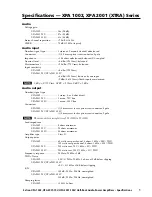
Glenayre Document Number: 9110.01306
GL-T8200 1- to 25-Watt 900-MHz Power Amplifier
Rev. A: 03/23/99
THEORY OF OPERATION
25
w
8
20
0
6
Print Date: 05/10/99
Copyright © 1999 Glenayre
Page: 6-7
6.5.1
PA Board Currents
The currents monitored in the PA board have various upper limits, as shown in Table 6-2.
They are read on the VDT screen. When one or more of these thresholds is met, it causes
an interrupt to the microcontroller in the exciter, which then reduces output power until the
fault condition no longer exists or until shutdown occurs. As of this printing, no lower
current limit has been programmed.
6.5.2
PA Forward Power
The PA board forward and reflected samples are digitized and sent out the I20 interface.
The forward power reading from the PA board has a lower limit which is determined by the
forward power setting of the transmitter. This limit is based on efficiency and losses in the
PA. The lower limit is 1 watt. The upper limit for the forward power reading is 25 watts.
This does not cause an interrupt to the exciter, but if a reading exceeds this level, the exciter
shuts the transmitter down.
6.5.3
PA Reflected Power
The reflected power reading in the PA has a lower limit of 0 W, and an upper limit of 5 W
average power. When this limit is achieved, it initiates an interrupt to the microcontroller
in the exciter which reduces power until the fault goes away or until a shutdown condition
occurs.
6.5.4
PA Board RF Input Power
The input power to the PA has a lower limit of 200 mW. If the threshold is not reached, the
PA shuts down.
6.5.5
+28-Volt External Supply
The upper limit of the PA’s 28 volt supply is +29 volts, and the lower limit is +22 volts.
Excursions outside these limits are a fault state. The transmitter shuts down.
6.5.6
+36-Volt Internal Supply
The +36 volt supply to the current metering op-amps has a window of +33 volts and +39
volts. When these limits have been exceeded, it results in an alarm condition only, no power
reduction.
















































